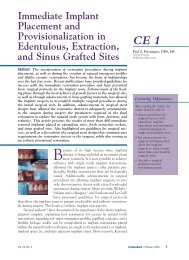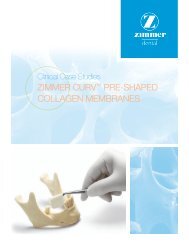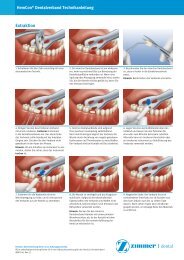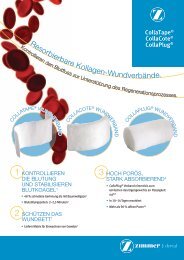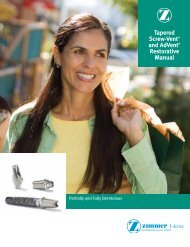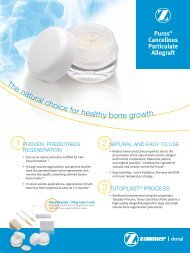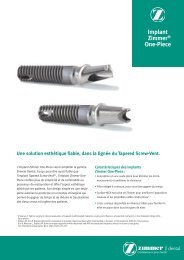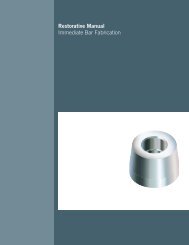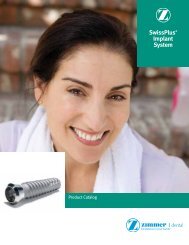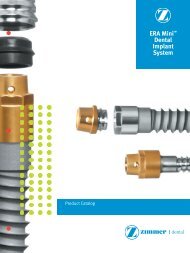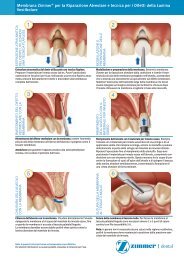Download English - Zimmer Dental
Download English - Zimmer Dental
Download English - Zimmer Dental
- No tags were found...
You also want an ePaper? Increase the reach of your titles
YUMPU automatically turns print PDFs into web optimized ePapers that Google loves.
Rock-solid fit.A connection you can depend on.Internal HexwithFriction-Fit
<strong>Zimmer</strong> <strong>Dental</strong>’s patentedfriction-fit abutment connection.Drive a piton deep into rock, and it locksfirm, giving the climber a solid securebase. Friction-fit abutments form a coldweld connection with the implant,essentially eliminating micromovement,tipping and the effects of vibration.Screw loosening virtually disappears,along with the hours spent on freeadjustments and remakes.Without friction-fit, other internalconnections face limitations as theeffects of micromovement may not becompletely eliminated. Only whenyou combine the two technologies,friction-fit and internal hex, do you reachthe most advanced evolution in implantconnections – <strong>Zimmer</strong> internal hex withfriction-fit.Friction-fit technology far surpassesthat of standard external and internalhex connections. External hexagons fallshort because they were originallycreated only to drive the implant into thesurgical site; their outdated design wasnever meant to serve as an anti-rotationaldevice.Male abutment hex witha one-degree taperLead-in bevelInternal hex 1.5mm deepFigure 1 Abutments for Tapered Screw-Vent ® and other <strong>Zimmer</strong>internal hex implants have a male hex that tapers one degreefrom the base of the abutment body to the bottom of the hex.As the abutment is seated into the implant under appliedtorque, the abutment hex frictionally engages the walls of theimplant's internal hex. The result is a friction-fit that virtuallyeliminates rotation between components.
<strong>Zimmer</strong> internal hex with friction-fit:Unmatchable performance by design.• The friction-fit of the 1.5mm deepinternal hex distributes forces deeperwithin the implant, shielding theretention screw from excessive loading. 1• Reduced screw loosening meansgreater patient satisfaction and lesstime spent on complimentaryadjustments and remakes.• The lead-in bevel improves ability toseat the abutment easily and properly.• Unique friction-fit abutments create avirtual “cold weld” with the implantwhen fully seated. This connectionvirtually eliminates rotational micromovement,tipping and vibration-relatedmicromovement of the abutment –leading causes of screw loosening.• The low profile of the internalconnection improves esthetics andallows for a more natural emergenceprofile, especially in esthetic areas.Natural esthetic result due todepth of prosthetic emergence allowedby internal hex connectionMetal exposure due toexcessive abutment cuff heightto accommodate external hexInternal hex with friction-fit –the esthetic solution*Implants highlighted in red indicate cross sections ofboth internal and external connections.External hex – inferior estheticsBulky emergence profile dueto excessive abutment flare toaccommodate external hex
<strong>Zimmer</strong> internal hex advantage.The only hex abutment that truly locks into place.Compared to other internalhex connections.• <strong>Zimmer</strong> <strong>Dental</strong> abutments for internalhex implants have a tapered male hexthat frictionally engages the implant,resulting in zero degrees of rotationalmovement between the implant andabutment when tightened to therecommended torque of 30Ncm. 1Compared to traditional externalhex connections.• <strong>Zimmer</strong> <strong>Dental</strong>’s internal hexwith friction-fit abutments virtuallyeliminates rotation when componentsare fully seated. 1• In contrast, external hexes typicallyhave a rotational misfit of 3 to 10degrees between the implant andVirtualcold weldAbutmentImplant• Without the friction-fit hex combination,implants with internal engaginggeometries are just like an externalhex turned upside down, allowing formovement between components.abutment. 2• Screw loosening of external heximplant components is documentedup to 38% of all single-tooth, partiallyand fully edentulous cases. 3Figure A SEM at 50Xmagnification shows intimatecontact of the internal heximplant at both the beveledimplant/abutment interfaceand the hexagonalengagement area.• To overcome rotational problemswith their connections, competitorshave attempted various designmodifications, including strengtheningscrews, increasing clamping forces,and varying hex dimensions. Only<strong>Zimmer</strong> <strong>Dental</strong> has an internal hexconnection that virtually eliminatesrotation by design.In the U.S., call your <strong>Zimmer</strong> <strong>Dental</strong>Sales Consultant or Customer Serviceat 800 854 7019 to find out how<strong>Zimmer</strong> friction-fit products canimprove your practice. Outside theU.S., please refer to the contactinformation located on the back ofthis brochure.Virtual coldweld at 150XmagnificationAbutmentImplantProudly offering one of the most comprehensive dental implant product lines available,<strong>Zimmer</strong> <strong>Dental</strong> is a market leader in the development of world-class implantologyproducts, practice-building strategies and educational programs focused on empoweringclinicians and improving patients’ lives.Figure B SEM at 150Xmagnification displays themechanical interlock in thehexagonal engagement areabetween the flats of theimplant and abutment.Intimate friction-fitRotation between the implant andabutment results in screw-jointloosening. <strong>Zimmer</strong> <strong>Dental</strong>’s friction-fitabutments virtually eliminate rotationwhen fully seated, minimizing costlyrepairs and repeat visits. ScanningElectron Micrographs reveal theintimate fit that results in a virtual“cold weld” of <strong>Zimmer</strong> <strong>Dental</strong>components (Figures A, B).
The evolution and evaluation of twointerference-fit implant interfaces.Abstract and ConclusionsBy Paul P. BinonPostgraduate Dentistry1996:3(1)Component misfit has been implicatedas one of several important factors inscrew-joint failure and screw loosening indental implants. Recent evidence indicatesthat rotational misfit may be moreimportant in screw-joint stability thanoriginally anticipated. Efforts have beenmade to reduce and/or eliminaterotational misfit with different nonrotatingimplant interfaces. The effectiveness ofan interference-fit implant interface isreported in this article. The implantswere evaluated for rotational movement,the intimacy and nature of hexagonalcontact, the adequacy of the implant/abutment interface seal, and machiningconsistency of the hexagonals andimplant. Currently available componentsare contrasted with components thatwere available initially in the evolution ofthe friction-fit/interference-fit interfaces.Significant improvements and refinementshave been incorporated into the currentgeneration of components.ConclusionsThe friction-fit hexagonal implant wasevaluated and contrasted for machiningconsistency, interface fit, and rotationalstability. From the data presented, thefollowing conclusions can be drawn:1. Rotational freedom (misfit) forthe [Screw-Vent] implant/abutmentsystems...was 0 degrees...when fullytightened to 30 Ncm.2. The SEM and microphotograph crosssectionsdocument intimate hexagonalcontact and interference fit that results inabutment rotational stability.3. Refinements in machining tolerancesand the availability of a reliable methodof torque application have resulted inpredictable and consistent implant/abutment interface seals.References1. Binon PP: The evolution and evaluation of twointerference-fit implant interfaces. Postgraduate Dent1996;3:3-13.2. Binon PP: Evaluation of machining accuracy andconsistency of selected implants, standard abutmentsand laboratory analogs. Int J Prosthodont1995;8:162-178.3. Goodacre CJ, Kan JYK, Rungcharassaeng K: Clinicalcomplications of osseointegrated implants. JProsthetic Dent 1999;8:537-552.Optical cross-sectionmicrographs of the Screw-Vent implant/abutmentcombination were evaluated.This image illustrates thetypical intimate contact andfriction-fit between theinternal straight hexagon ofthe implant and the external1-degree tapered hexagonof the abutment.The beveled seating areaalso demonstrates fullcontact and an intimate seal.
For more information about our Products, Professional Programsand Continuing Education, contact us:1900 Aston AvenueCarlsbad, CA 92008-7308, USAIn the U.S. 800 854 7019To fax an order 888 225 2483Outside the U.S. +1 760 929 4300Australia +61 2 4297 4182 or 1800 241 916Canada +1 800 265 0968 or 1 905 567 2073France +33 (0)1 45 12 35 35Germany +49 (0)761 4584 722/723Israel +972 (0)3 6124242Spain +34 93 846 05 43© 2005 <strong>Zimmer</strong> <strong>Dental</strong> Inc. All rights reserved. 4924, Rev. 01/05.To receive our eNews visit us at http://www.zimmerdental.com/news_eNewsLetterSignUp.aspxwww.zimmerdental.com



